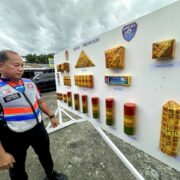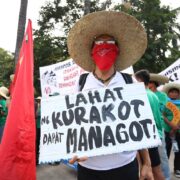Learning Spanish

Ateneo graduates of a certain generation all used the same Spanish language textbook. We all know about the adventures of Ana West, and how to order an orange juice (jugo de naranja) from a waiter (mesero). We had 12 units of Spanish but didn’t get to the end of the textbook. We never got to Spain, we only got around to Mexico. Former president Benigno “Noynoy” Aquino III recalled how his Ateneo Spanish classes came in handy when he met the President of Mexico. He referred to the Avenida de la Reforma and the Parque de Chapultepec that he had never visited but only knew from our college Spanish textbook.
If you haven’t tried it yet, download Duolingo and have fun learning a foreign language. I tried it for Japanese but didn’t progress beyond “Konnichiwa.” I settled on Spanish and French. The app is interactive and it sharpens listening and speaking skills, it also teaches you how to compose simple narratives. If this was the way Spanish was taught in college my generation would be competent after completing 12 units. Duolingo gives real life situations: going to the movies, ordering in a restaurant, going camping in the mountains. The Spanish you learn is colloquial with everyday expressions you will hear in Spain. If I had Duolingo 30 years ago, I wouldn’t have made the mistake of entering a bakery and asking the proprietress for the price of the “mamon” in the shop window. She said that what I wanted were “magdalenas.” I was to find out later that mamon is the vulgar Spanish word for breasts! In the Philippines, we have lemon mamon, toasted mamon, even fluffy mamon. We actually have breads called monai and pan de regla; we even have a coconut jam that comes in circular round containers called sundot kulangot, and there is a sesame roll known as “ampao” that Kapampangans refer to as “taklang pusa” (cat sh*t).
In Philippine cinema, the villain is called “kontrabida” from the Spanish contra (against) vida (life). You see the connection more clearly when you use the round rubber inflatable floaties we know generically as “salbabida” that is Spanish for salva (save) and vida (life). Salbabida are lifesavers, not the hard candy. Then we have the Philippine term “salvage,” an English word that means to save or recover, but in the Philippines the term now refers to EJK or extrajudicial killings. How did this come about? “Salvaje” is the Spanish word for savage, when used as a verb in the Philippines as in “sinalbahe,” it means to savage or brutalize. Salvaje, written in Spanish but read as English, became salvage and that explains the shift in meaning.
In colloquial Filipino, the word for going out for a walk is “pasyal,” obviously from the Spanish verb “pasear.” But what is more intriguing is that there is another term for pasyal and it is, pardon the expression, “lamierda.” Spelled as one word and used as a verb, “Mag-lamierda tayo” is an invitation to chill outside the home. How did this vulgar Spanish term for excrement or sh*t change its meaning after being transplanted to a new land and a new culture? That is a question we leave for the philologists and linguists.
Another example of the (mis)reading of Spanish in the Philippines concerns names, surnames, and place names of Spanish origin, tangible proof of the Spanish presence in the Philippine past. Spanish surnames that are common in the Philippines: Cruz, Dela Cruz, Santos, De Los Santos, Guerrero, Bonifacio, Aguinaldo, Luna, Rizal were imposed in the 19th century for purposes of census and taxation. In those days, when a baby was born, its name was chosen from the most popular Spanish form for Jesus, Mary, or Joseph; that’s why we have the exclamation “susmariosep!” Or why the former vice president was named JEJOMAR for Jesus, Jose, and Maria. Other children were not as lucky, their names were picked out of a calendar that had the names for the saints of the day. So Asuncion was a girl born on Aug. 15, feast of the Assumption; Concepcion was born on Dec. 8, feast of the Immaculate Concepcion; and Natividad was born on Dec. 25, Christmas Day. Someone born on Jan. 1 was called Circumcision, the former feast of the Circumcision of the Lord that has been changed to the Solemnity of Mary Mother of God.
While we are at it, one of Manila’s most sought after fashion designers in the past century was Jose Moreno more popularly known by his nickname “Pitoy.” His social and professional name “Pitoy Moreno” was a byword in Philippine fashion. Pitoy Moreno can be declared casually and without malice in Manila, but in Madrid it was something else. Pitoy would neither confirm nor deny that during his first fashion show in Madrid. People fell off their seats laughing when he was introduced because moreno means dark or brown, when he was fair-complexioned, and pito is the vulgar word for penis. Pitoy Moreno in Spanish was little brown penis.
These amusing examples illustrate how Spain and Spanish are remembered in the Philippines today, and how language is often the source for mixed signals.
—————
Comments are welcome at aocampo@ateneo.edu
Ambeth is a Public Historian whose research covers 19th century Philippines: its art, culture, and the people who figure in the birth of the nation. Professor and former Chair, Department of History, Ateneo de Manila University, he writes a widely-read editorial page column for the Philippine Daily Inquirer, and has published over 30 books—the most recent being: Martial Law: Looking Back 15 (Anvil, 2021) and Yaman: History and Heritage in Philippine Money (Bangko Sentral ng Pilipinas, 2021).


















